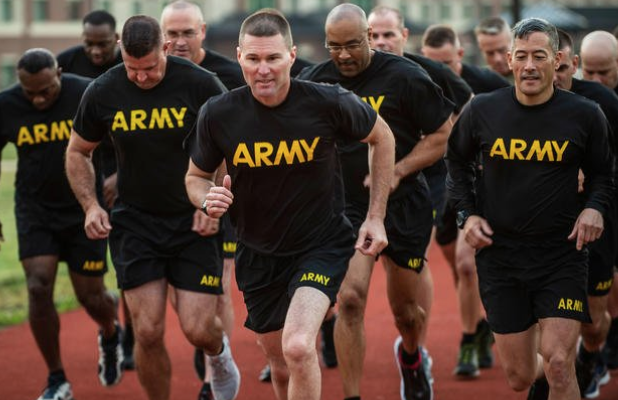By Jeff Sonderegger
BLUF
This 3-week mini-study compared the improvements in 2-mile run times between individuals training with a run-emphasis and those training with a strength-emphasis program.
Lab rats, all of whom are currently serving in the United States Army, were broken into two groups, with Group A performing a plan focused on running and Group B conducting a plan with a strength-emphasis. Both groups conducted an assessment on Day 1 of Week 1, running and recording their 2-mile. Group B then conducted a Relative Strength assessment on Day 2.
Below is the general layout of the 3 training weeks:
- Group A (Strength hybrid) ran 3 pace routines and did 2 strength sessions/week.
- Group B (Endurance) ran 3 pace routines and 2 slow endurance runs/week.
Unfortunately, due to COVID-19 restrictions, as well as outbreaks, only 4 individuals were able to compete the mini-study, with 2 in each group.
The results of the study proved indecisive. This is likely due to the small number that completed the lab as well as the fact that 3 of the 4 participants had never conducted a training plan with a focus on improving running previously.
BACKGROUND & STUDY DESIGN
There are several schools of thought in the realm of increasing endurance capacity/speed over distance. From Mike Boyle’s emphasis on timing drills, to Stephen Seiler’s 80-20 rule, to Ryan Flaherty’s strength and stride work, to the ultra-prominent rise of High Intensity Interval Training since the advent of CrossFit. But before a proper comparison and contrast of any of these concepts can be undertaken, a simple, stripped-down comparison of strength emphasis v. running emphasis seemed the appropriate starting point.
Mountain Tactical has conducted several studies, particularly with regards to rucking, comparing the results of similar emphases. In the case of rucking, a strength or hybrid-strength program proved more effective. This makes sense given the additional strength and impact-durability requirements for rucking. But the question we wanted to answer was – with simple, unweighted endurance, will a hybrid program still yield higher benefits than focusing simply on running?
As stated above, the mini-lab was 3 weeks in duration, plus two days for attaining metrics. Below is the Group A (Strength) weekly schedule:
- Monday: (Weeks 1, 4) 2-mile assessment / (Weeks 2-3) 800 Meter Repeats
- Tuesday: (Weeks 1, 4) Relative Strength Assessment: Front Squat, Bench Press, Hinge Lift, and Max Pullups / (Weeks 2-3) Strength – Front Squat, Bench Press, Hinge Lift and Pullups
- Wednesday: (Weeks 1-3) 1 Mile Repeats
- Thursday: (Weeks 1-3) Strength – Front Squat, Bench Press, Hinge Lift, and Pullups
- Friday: (Weeks 1-3) 800 Meter Repeats
The Group B (Endurance) weekly schedule:
- Monday: (Weeks 1, 4) 2-mile assessment / (Weeks 2-3) 800 Meter Repeats
- Tuesday: (Weeks 1-3) Long Endurance Run
- Wednesday: (Weeks 1-3) 1 Mile Repeats
- Thursday: (Weeks 1-3) Long Endurance Run
- Friday: (Weeks 1-3) 800 Meter Repeats
RESULTS AND DISCUSSION
As stated in the beginning, the results of this mini lab, unfortunately, proved indecisive. There are several factors playing into this fact. Chief among them, surely, being the incredibly small test group. We initially began with 8 lab rats but lost four to COVID restrictions, sickness, and work-related injuries.
Second, 3 of the individuals who completed the mini-study had completed only strength programming for years. By their own admission, these three individuals had only completed an endurance event twice in a year – the 2-mile run in the APFT – and only because it is required of them. Because of this, the simple fact that they were conducting endurance/speed training at all, but especially in the volume required by this lab, was bound to see massive improvements in their short-range endurance capacity. Even over a period of only 3 weeks.
The results for assessment times were as follows:
The averages in time- and percentage-improvements between groups were almost indistinguishable. When looking at individual improvements, the three people for whom this was the first dedicated and focused endurance work in a significant amount of time saw huge improvements, ranging from just over 8% to just under a whopping 17%.
Though such dramatic results were admittedly shocking, given the short timeframe, the spread in improvements was distributed between the groups in such a way that made the results far from telling.
NEXT STEPS
The clear next step is to conduct the study with a larger test group which includes individuals with varying backgrounds in endurance training spread evenly among the different emphases. Only these parameters will create an environment that allows for useful data collection.
It would also be valuable to increase the assessment distance for a future study, as this will cause a greater demand for endurance capacity increase and a greater variance in time-improvements between the two groups. Because 2 miles is a short enough distance for individuals to be able to remain anaerobic for the entire duration of the event, the training program as it was written lends itself to both groups achieving roughly indecisive results. Both groups are getting the same amount of anaerobic work, so naturally, their improvements for the generally anaerobic assessment will be similar.
The results from this lab will also open the door to then complete more specific labs in relation to the different schools of thought mentioned in the Background paragraph. It will serve as a rough basis on which such studies can be built, with the ultimate goal being to eventually, by work and data-capture, determine which of these schools of thought are credible and which are simply time-wasters.
Questions, Comments Feedback? Email coach@mtntactical.com
You Might Also Like Mini-Study: Endurance Training Doing Step Ups Does Transfer To Running, but Only Half As Well
STAY UPDATED
Sign-up for our BETA newsletter. Training tips, research updates, videos and articles - and we’ll never sell your info.


